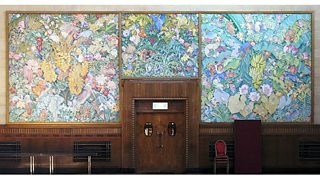Many people in Wales have visited . They may even have seen the Empire Panels that are now housed there. But how many know anything at all about the man who created such magnificent works of art, and after whom the hall is named?

Panels at the rear of Bangwyn Hall 脗漏 Copyright Nigel Jones
Frank Brangwyn was born at Bruges on 12 May 1867. He was the son of Anglo-Welsh parents; his father, William Curtis Brangwyn, was a specialist in ecclesiastical architecture and textile designs. William won a commission to adapt and design a church in the Belgian city and duly moved there with his family.
When Frank was born he was registered as Guillaume Fran莽ois, as you might expect in a French speaking part of the world. However, to the family and the world he was always Frank.
The Brangwyn family returned to Britain in 1874, taking up residence in London. Frank received no formal training as an artist, being almost entirely self taught. His father undoubtedly advised him and he did work - or study - for a while with Arthur Mackmurdo in the workshops of the famous William Morris. But there was no formal college training.
His breakthrough came at an early age. When he was just 17, Brangwyn had a painting accepted by the Royal Academy for their summer exhibition and overnight his career was launched. He loved light, bright colours and his travels in southern Europe and to the near east only confirmed his enjoyment of light and shade.
Being notoriously short of money, Brangwyn worked as a deck hand at sea in order to fund one particular trip, in 1888, to Turkey. It was a journey full of enjoyment and sensual delight and he went on to paint, among other countries, places as varied as Egypt, Morocco and Spain. He particularly enjoyed painting the sea, where the light seemed especially vivid.
One of his early successes, winning the 1891 Paris Salon, was Funeral At Sea, although the finished work was rather drab and grey - certainly not full of the brightness and vitality with which he is usually associated. As a work of art, however, it is stunningly realistic and certainly captures the solemnity of the occasion.
During World War One Brangwyn produced over 80 poster designs, aimed at recruitment and helping the war effort. The most famous of these was the depiction of a British soldier bayoneting a German during a trench raid.
So realistic and horrifying was this picture that it caused a great deal of offence, both in Germany and Britain. It was even rumoured that the Kaiser had put a price on Brangwyn's head - something that was eminently possible as he had already done this with the Dutch artist Louis Raemaekers for his depictions of German barbarity in Belgium earlier in the war.
Brangwyn's war work - he spent some time as an official War Artist - was brutally realistic. He produced, amongst other pieces, a poster to help in a fund raising event for Welsh troops and, one of his finest creations, Tank In Action.
Between 1925 and 1932 Brangwyn was commissioned to produce a series of panels for the Royal Gallery in the House of Lords. However, the end product - covering over 3,000 square feet of wall space - was considered to be too colourful for such a sombre setting and the paintings were rejected. They were donated instead to Swansea Guildhall and now hang in Brangwyn Hall in the south Wales city.

Brangwyn Hall, 1949
In his career Frank Brangwyn produced an enormous amount of work. It ranged from paintings, ceramics to drawings and etchings. He made stained glass windows and illustrated books. He also drew for illustrated magazines such as The Graphic.
In the years before the outbreak of World War Two he designed the interiors for the luxury liner Empress of Britain. His work on this magnificent vessel now lies at the bottom of the ocean as the ship was torpedoed and sunk during the war.
In 1936 this prolific and exceptional artist presented over 400 pieces of his work to Bruges, the city of his birth. It was a generous gesture but, of course, there was limited viewing of the work due to the outbreak of war in 1939.
In a career that spanned 70 years, Brangwyn was hugely successful but never really part of the establishment. Critics simply did not know how to label him, did not know quite where he could be pigeon holed. At a time when artists like Burne-Jones, Sargent and Whistler were still popular, Brangwyn simply did not fit in.
He died at his home in Ditchling, Sussex, in 1956. His wife, Lucy Ray, had died in 1924. They had no children.
For a man who had achieved success at an early age, official recognition came rather late in life. It was not until 1941 that Brangwyn received a knighthood and for a true renaissance artist - he was, amongst other things, a painter, engraver and designer - it was a tribute that was well deserved. Take a trip to Swansea's Brangwyn Hall and see for yourself.
